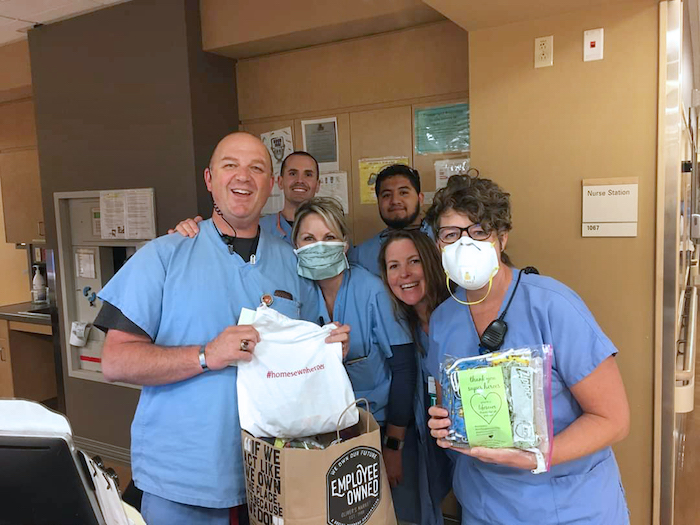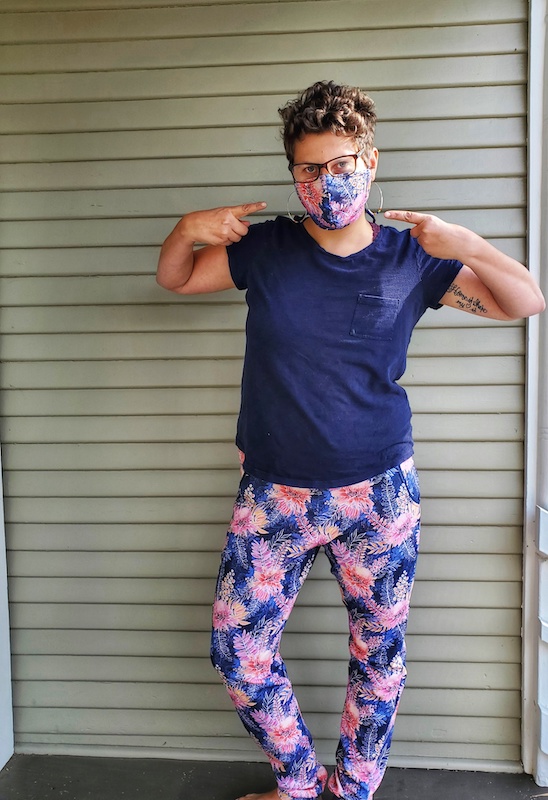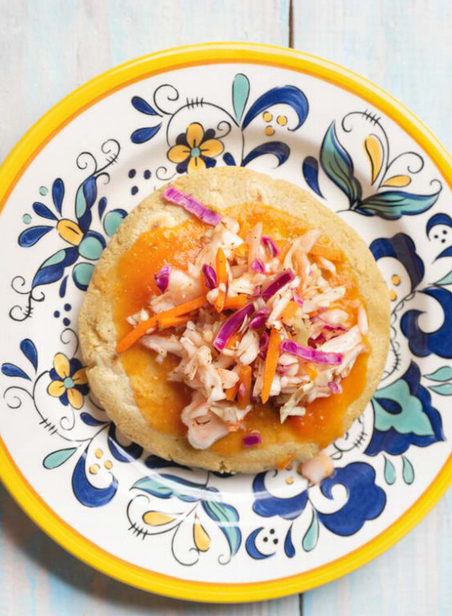Stories of Hope
One Stitch at a Time: How a few women created the mask-making machine of North Bay Sewists Unite!

It was not the kind of spring “break” any of us wanted. By the time the equinox rolled around, Sonoma County was days into the mandatory shelter-in-place order that separated us from friends, extended family, happy hours, hikes, playdates—a deep and sudden rift that most of us were ill prepared for.
Including our local hospitals. Indeed, as doctors, nurses, grocery store clerks, delivery drivers, and other frontline workers were soon to find out, the county was ill-equipped to provide PPE (personal protective equipment) to those people whose jobs could not be conducted from home. On March 21, in response to the growing requests on social media, a few mom friends started a chat about joining forces to sew some masks for those in need. The four sewists—Natalie Hoytt, Quinn Roncarati, Kelley Payne, and Nada Hadley—shared the idea on their personal pages and among various groups, hoping to get a few more interested folks. Within two days, they had 300 volunteers and hundreds of requests.

“We realized we needed some organization,” says co-founder Nada Hadley over the phone in early April. “We never thought it would get so big.” Indeed, less than two weeks in and their group—which they named North Bay Sewists Unite!—had nearly 1,000 volunteers and thousands more pending requests.
So they created two forms: one for people and businesses requesting donations and one for the volunteers to enumerate the materials they needed. Donations of cotton have been plentiful, but more elusive is the wire (to get that crucial fit over the nose) and the elastic. “I just spent 300 dollars on 400 yards of elastic,” says Hadley, who set up a Paypal account for monetary donations.
Their first big donation was 200 masks to the ER at Memorial. As of our phone call they’d already donated 3,000 masks—to Kaiser, Sutter, SRPD, Santa Rosa Community Health, Oliver’s, and several elderly homes. They’d also been contacted by folks as far away as Colorado, who are replicating their well-oiled model in their locales.
Clementine Lee joined the crew just as cancellations were crashing her face painting business right as the busy season was about to begin. “Now I’m sewing non-stop,” says Lee, who also operates The Kind King Clothing company from her home. “Between clothing and masks, I’m working like 12 or 13 hours a day sewing. It’s therapeutic.”
Lee started her clothing company after losing her house to the Tubbs Fire in 2017. “I think that’s why I’m not really shocked by this,” she tells me over the phone one evening. “We really have no idea what’s gonna happen.”
What she does know: how to produce 100 masks in two days. She first cuts hundreds of patterns, assembly-line style, then sews each mask in 5-10 minutes. Lee, who made a video tutorial for the group, is using an intermediate pattern that she modified to be highly versatile: “Anybody can use it,” she explains. “It has a pocket for a filter, and can either be tied behind the head or used with elastic ear loops.”
Both Hadley and Lee have three kids each, as do many of the sewists. But some of them are older, perhaps with more time on their hands, and as Lee notes, “Instead of being afraid, they’re helping.” Lee says it’s nice to (distantly) chat when folks come by her house to pick up materials or drop off masks. The well-organized group has drop-off locations in Petaluma, Santa Rosa, Sebastopol, Windsor, and Rohnert Park.
Recently a woman approached her wanting to donate face shields she’d generated using a 3-D printer. “People are waiting for the opportunity to help,” says Lee—and people are clearly in need. Within days, there were 700 requests for face shields.
As of this writing in mid-April, North Bay Sewists Unite! has more than 1,300 volunteers who’ve donated some 5,000 masks—and are still working to meet 15,600 pending requests. As Hadley puts it: “There’s no end in sight.”
Snapshot of a Local Artist: Ernesto M. Garay
Ernesto M. Garay is an award-winning poet, performer, teacher and social activist. He holds two master’s degrees: one in Comparative Literature and the other in Ethnic Studies. He is a widely published poet in both Spanish and English. Mr. Garay teaches poetry to children, teens and adults living with intersectional vulnerability, in schools and organizations in Sonoma County.
 Presently, Garay is finishing his book of poetry, Reverberating Voices. Traversing the borders of El Salvador, Nicaragua, Mexico, and California, it speaks about the experience of immigration, racism, healing the spirit, displacement and love during the Central American Civil Wars of the 1970s and 1980s.
Presently, Garay is finishing his book of poetry, Reverberating Voices. Traversing the borders of El Salvador, Nicaragua, Mexico, and California, it speaks about the experience of immigration, racism, healing the spirit, displacement and love during the Central American Civil Wars of the 1970s and 1980s.
Garay is passionate about social justice and advocating for the Latino immigrant community. He inspires us and moves among us with unfailing humility, generosity and grace.
Editor’s Note: In response to the school shutdowns, the nonprofit California Poets in the Schools is providing free online poetry classes for students of all ages. “It’s a small thing we can do from home,” says executive director Meg Hamill, who lives in Santa Rosa. Find some 30 lessons, including Garay’s free verse lesson, “Starry Night,” at: californiapoets.org/online-poetry-workshop-for-youth
How to Make Pupusas – By Ernesto Garay

Tip the sun into the bowl. You can honor and remember your Mayan ancestors who never faded away or disappeared like the mist in the morning. You fill it with one cup of vegetable oil, corn masa flour, and one cup of water, mixing it in.
You start kneading the masa like Mama does it with her soft-smooth hands that have gently rubbed your forehead, to rub away your migraine headaches; she rolls the masa into balls, makes an indentation with her right thumb, and fills it with cheese or other ingredients (I love the combination of cheese with loroco, the herbaceous flower bud).
With Mama’s therapeutic hands, she pats it into a round tortilla. Then she grills the pupusa on the comal until it browns on both sides.
Eat the hardened rainbow with your crimson sky mouth and celebrate Easter Sunday. Hide the milk-chocolate Easter bunnies behind the blueberry bushes that stand tall above the cheery children and serve the pupusas with horchata and a plate of rice and beans.
If Dad and Mom are laid off—don’t worry—pupusas are on the cheap to make. Dance cumbia and salsa and make more. This is how we party!
A Powerful Tribe of Do-gooders – By Playalina Nelson
During the COVID-19 pandemic and the current shelter-in-place order, many more people are becoming food insecure as they lose their income and their ability to work. The Redwood Empire Food Bank (REFB) has stepped up to this challenge with adaptability and strong partnerships to bring hope and resiliency to Sonoma County.
Since the outbreak, REFB has seen a massive spike in demand for food assistance. According to Nicole Lorange, hunger relief worker at REFB, participants have nearly doubled: “In an average year, we serve 82,000 individuals and families. With the COVID-19 outbreak, we’re projecting to feed 164,000 people.” On average, REFB distributes nearly 300 emergency food boxes out of the Food Connections office a month. During COVID-19, numbers have surged to more than 450 in a week. Similarly, customers at the Food Connections Market nearly doubled to 800 people seeking food assistance in recent weeks.
The REFB relies on 8,500 volunteers throughout the year. Since local volunteers are now mandated to stay home, the National Guard, the US Coast Guard, and Team Rubicon will be packing emergency food boxes. The REFB is also partnering with Santa Rosa Junior College’s Feed the Bears Food Pantry to provide periodic drive-thru food distribution.
Food boxes are being prepacked and most distribution sites are drive-thru to ensure social distancing. Forty volunteers work each shift, broken into four groups of ten, with everyone spaced six feet apart.
“Now more than ever,” Lorange states, “we are in dire need of food, funds, and volunteers. It’s not one or the other—we need all of it. If you have yet to join our powerful tribe of do-gooders, we eagerly await your participation. Every dollar, every minute, and every food donation makes a difference.”
411
To learn more about how you can support REFB: refb.org/ways-to-give
To learn about REFB food distribution sites: getfood.refb.org or 707-523-7903
For info about SRJC Feed the Bears Food Pantry: resources.santarosa.edu/food-resources
